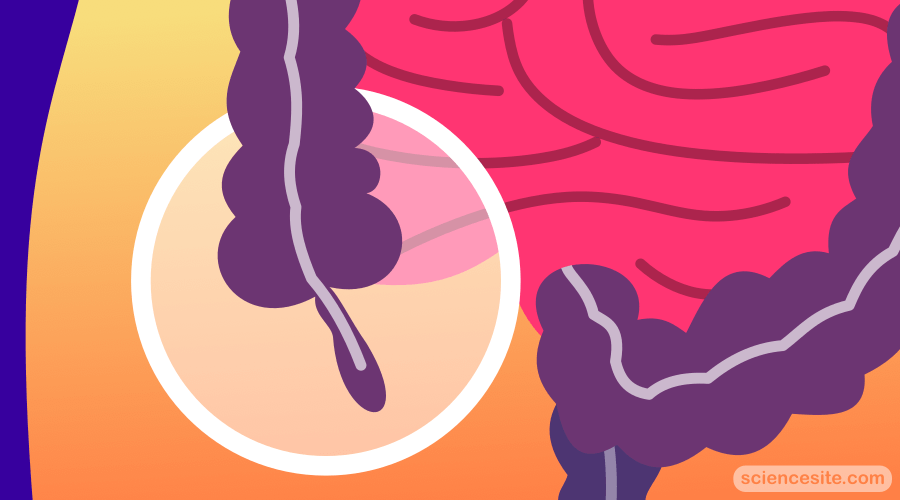The appendix has been a mystery to humans and scientists since its discovery, as it seems like an organ that does not appear to perform any function in the human body. So, why do you think it’s part of our digestive tract?
It is part of the gastrointestinal tract and only seems to cause problems that require it to be operated on and taken out. So, let’s study the mystery behind this human organ.
The Location of the Appendix
The appendix can be seen in the lower right part of the abdomen. This part of the abdomen is referred to as McBurney’s point by doctors. When you apply pressure on the point and feel pain or tenderness, the doctor will suspect that you have appendicitis, which requires the appendix to be cut out before it can burst.
The appendix is about four inches long thin tube that looks like a finger. It is attached to the part of your large intestine which is called the cecum. The cecum is a small pouch that is actually considered as the starting part of your large intestine.
What is the Function of the Appendix?
The Gastrointestinal (GI) tract of your body helps in the digestion of food with the use of hormones and enzymes that are produced in the track. However, the exact role of the appendix in the system is still unclear.
This is because even if the appendix is removed from the body, there are no negative effects that can be observed in the digestion of food. With no health consequences to face after the removal of the appendix, made the scientists believe that it was a vestigial organ that has no functionality after the years of evolution.
This is also because scientists were unable to locate an appendix in any other mammal except for the close relative of humans that are apes.
However, in other plant-based mammals, it is observed that they have a larger cecum in their body than humans, which made Charles Darwin to theorize that the ancestors of humans used to have larger cecum just like the herbivores of today.
As humans are not able to digest plants like herbivores, it is said that our ancestors shifted to a fruit-based diet that led their cecum to shrink and eventually lose its functionality altogether. Scientists believe that it will completely disappear in further years of evolution.
Appendix: The “Safe House” of the Body
Today, some scientists have come out with another theory. They believe that the appendix is not useless, it plays a part in recovering the gut after it suffers from a gastrointestinal disease.
This is because the appendix in the human body contains a specific tissue that is associated with the lymphatic system. This tissue carries white blood cells that fight different infections. How does the appendix work here?
Well, recently it was discovered that lymphatic tissues help in the growth of abdominal bacteria that are beneficial to the body and help greatly in human immunity and digestion. More studies show that the gut lining contains a thin lining of mucus, microbes, and molecules of the immune system also called a biofilm. And it was observed that this biofilm is most pronounced in the appendix.
Therefore, the “Safe House” theory states that the appendix plays a part in protecting the gut bacteria that get wiped out with different diseases in the GI tract. When the immune system heals the body from the infection, the bacteria reemerge from the biofilm of the appendix and recolonize.
Health Issues due to the Organ
There are some health issues that come with this mysterious organ though. The appendix can sometimes get inflamed and infected, giving way to a condition called appendicitis.
Appendicitis can be caused in two ways. Either an abdominal infection travels to the small organ and causes it to become infected or some kind of blockage gets in the way of the small opening of the appendix and obstructs it,
Some things that result in the blockage include:
⦁ GI Tract ulcers
⦁ Intestinal worms or parasites
⦁ Hard stool pieces
⦁ Enlarged appendix lymphatic tissue
⦁ Trauma to the abdomen
⦁ Any ingested objects like air gun pins and pellets
This blockage or infection can cause the bacteria found in the appendix to grow uncontrollably which results in swelling up the organ and filling it up with pus. This condition is called appendicitis. This disease causes intense pain in the abdomen and other symptoms that relate to the digestive system like diarrhea or vomiting.
When this condition takes place, there is no other option than the removal of the appendix. This is called an appendectomy. Sometimes, your doctor will prescribe some antibiotics to treat the infection without operating it. However, after judging the severity of the case, your doctor will decide the course of action that they should take. Other health issues also come into play.
If this problem remains untreated, the pressure in the appendix will keep growing, which can result in its rupture, and eventually, the appendix will burst.
If this infection causes the appendix to burst, all the content of the abdomen spreads throughout it and infects the peritoneum. This peritoneum is a silk-like membrane found in the abdominal cavity. If this is infected; the resulting infection is called peritonitis which can lead to sepsis. This is a condition that can become fatal if it’s not aggressively treated.
Wrapping Up
The appendix can be a useful organ in the body or a vestigial one; its removal, however, does not have any negative consequences on the body. It still needs research and scientists are working on figuring out the mystery that surrounds this organ.


